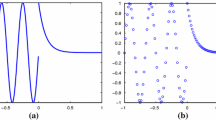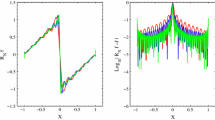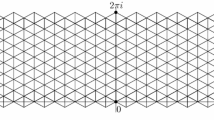Abstract
We address an ill-posed inverse problem of image estimation from sparse samples of its Fourier transform. The problem is formulated as joint estimation of the supports of unknown sparse objects in the image, and pixel values on these supports. The domain and the pixel values are alternately estimated using the level-set method and the conjugate gradient method, respectively. Our level-set evolution shows a unique switching behavior, which stabilizes the level-set evolution. Furthermore, the trade-off between the stability and the speed of evolution can be easily controlled by the number of the conjugate gradient steps, thus avoiding the re-initialization steps in conventional level set approaches.
Similar content being viewed by others
References
Adalsteinsson, D. and Sethian, J.A. 1999. The fast construction of extension velocities in level set methods. J.Computational Physics 148(1):2–22.
Ambrosio, L. and Tortorelli, V. 1990. Approximation of functionals depending on jumps by elliptic functionals via Γ-convergence. Comm.Pure Appl.Math. (8):707–711.
Blahut, R.E. 2001. Theory of Remote Image Formation. Cambridge University Press: Cambridge, UK. (preprint).
Bresler, Y. and Feng, P. 1996. Spectrum-blind minimum-rate sampling and reconstruction of 2-D multiband signals. In Proc.3rd IEEE Int.Conf.on Image Processing, ICIP'96, vol. I., Lausanne, Switzerland, pp. 701–704.
Bresler, Y., Gastpar, M., and Venkataramani, R. 1999. Image Compression On-the-fly by universal sampling in Fourier imaging sys-tems. In Proc.1999 IEEE Information Theory Workshop on Detection, Estimation, Classification, and Imaging. Santa-Fe, NM, pp. 48–48.
Chakraborty, A., Staib, L., and Duncan, J. 1996. Deformable bound-ary finding in medical images by integrating gradient and region information. IEEE Trans.on Medical Imaging, 15:859–870.
Chan, T. and Vese, L. 1999. An active contour model without edges. In Scale-Space Theories in Computer Vision. Corfu, Greece.
Chan, T. F. and Vese, L.A. 2000. Alevel set algorithm for minimizing the Mumford-Shah functional in image processing. Technical Report, University of California, Los Angeles.
Charbonnier, P., Blanc-Férand, L., Aubert, G., and Barland, M. 1997. Deterministic edge-preserving regularization in computed imaging. IEEE Trans.on Image Processing, 6(2):298–311.
Delaney, A.H. and Bresler, Y. 1998. Globally convergent edge-preserving regularized reconstruction: An application to limited-angle tomography. IEEE Trans.on Image Processing 7(2):204-221.
Dorn, O., Miller, E., and Rappaport, C. 2000. A shape reconstruction method for electromagnetic tomography using adjoint fields and level sets. Inverse Problems 16(5):1119–1156.
Gastpar, M. and Bresler, Y. 2000a. On the necessary density for spectrum-blind nonuniform sampling subject to quantization. In Proc.of IEEE Int'l Conf.on Acoust., Speech and Sig.Proc. Istanbul.
Gastpar, M. and Bresler, Y. 2000b. On the optimum density for nonuniform sampling. In Proc.ISIT, Internationanl Symposium on Information Theory. Sorento, Italy.
Geman, D. and Yang, C. 1995. Nonlinear image recovery with half-quadratic regularization. IEEE Trans.on Image Processing, 4(7):932–946.
Jchan-Besson, S., Barland, M., and Aubert, G. 2001. Video object segmentation using Eulerian region-based active contours. In Int.Conf.on Computer Vision. Vancouver.
Lanterman, A.D. 1999. Tracking and recognition of airborne targets via commercial television and FM radio signals. In Acquisition, Tracking and Pointing XIII, vol. 3692. Orlando, FL.
Leclerc, Y.G. 1989. Constructing simple stable descriptions for image partitioning. International Journal of Computer Vision 3(1):73–102.
Luenberger, D.G. 1989. Linear and Nonlinear Programming, 2nd edn. Addison-Wesley: Reading, MA.
Malladi, R., Sethian, J., and Vemuri, B. 1995. Shape modeling with front propagation: A level set approach. IEEE Trans.on Pattern Analysis and Machine Intelligence 17(2):158–175.
Mumford, D. and Shah, J. 1989. Optimal approximations by piecewise smooth functions and associated variational problems. Comm.Pure Appl.Math. (42):577–684.
Osher, S.J. and Sethian, J.A. 1988. Fronts propagating with curvature dependent speed: Algorithms based on Hamilton-Jacobi formulation. J.of Comp.Phys., 79:12–49.
Paragios, N. and Deriche, R. 1999. Geodesic active regions for motion estimation and tracking. In Int.Conf.on.Computer Vision. Corfu, Greece.
Richardson, T.J. 1989. Scale independent piecewise smooth segmentation of images via variational methods. Ph.D. Dissertation, Mass. Inst. Technol.
Santosa, F. 1996. A level-set approach for inverse problems involving obstacles. ESAIM: Control, Optimisation and Calculus of Variations, 1:17–33.
Sethian, J.A. 1996. Level Set Methods and Fast Marching Methods. Cambridge University Press: United Kingdom.
Sokolowski, J. and Zolesio, J. 1991. Introduction to Shape Optimization: Shape Sensitivity Analysis. Springer-Verlag: New York.
ter Haar Romeny, B.M. 1994. Geometry-Driven Diffusion in Computer Vision. Doerdrecht, Kluwer Academic Publishers: The Netherlands.
Tsai, A., Yezzi, A., and Willsky, A. 2001. Curve evolution implemen-tation of the Mumford-Shah functional for image segmentation, denoising, interpolation, and magnification. IEEE Trans.on Image Processing 10(8):1169–1186.
Venkataramani, R. and Bresler, Y. 1998. Further results on spectrum blind sampling of 2D signals. In Proc.IEEE Int.Conf.Image Proc., ICIP, vol. 2. Chicago, pp. 752–756.
Ye, J.C., Bresler, Y., and Moulin, P. 2000. Asymptotic global con-fidence regions in parametric shape estimation problems. IEEE Trans.on Information Theory 46(5):1881–1895.
Ye, J.C., Bresler, Y., and Moulin, P. 2001a. Cramér-Rao bound of shape estimation in inverse problems. IEEE Trans.on Image Pro-cessing, to appear.
Ye, J.C., Bresler, Y., and Moulin, P. 2001b. Cramér-Rao bounds for 2-D target shape estimation in nonlinear inverse scattering problems with application to passive radar. IEEE Trans.on Antennas and Propagat. 89(5):771–783.
Yu, D.F. and Fessler, J. 2001. Edge-preserving tomographic reconstruction with nonlocal regularization. IEEE Trans.on Image Processing, submitted.
Zhu, S.C. and Yuille, A. 1996. Region competition: Unifying snakes, region growing, and Bayes/MDL for multiband image segmentation. IEEE Trans.on Pattern Analysis and Machine Intelligence 18(9):884–900.
Author information
Authors and Affiliations
Rights and permissions
About this article
Cite this article
Ye, J.C., Bresler, Y. & Moulin, P. A Self-Referencing Level-Set Method for Image Reconstruction from Sparse Fourier Samples. International Journal of Computer Vision 50, 253–270 (2002). https://doi.org/10.1023/A:1020822324006
Issue Date:
DOI: https://doi.org/10.1023/A:1020822324006




